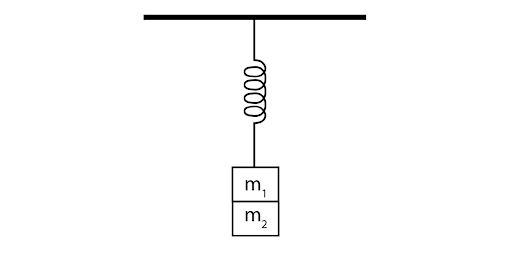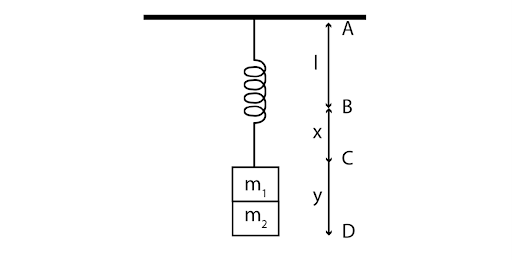
Two masses ${m_1}$and ${m_2}$ are suspended together by a massless spring of constant K. When the masses are in equilibrium, ${m_1}$is removed without disturbing the system. The amplitude of oscillations is

A. $\dfrac{{{m_1}g}}{K}$
B. $\dfrac{{{m_2}g}}{K}$
C. $\dfrac{{({m_1} + {m_2})g}}{K}$
D. $\dfrac{{({m_1} - {m_2})g}}{K}$
Answer
220.8k+ views
Hint:The problem is from the oscillations and waves section of physics. We have to apply the concepts of spring constant and vibrations to solve this problem. We can write the equation of motion for the two cases. When two masses are attached and when one mass is removed. After that from those two equations, we can find the amplitude of the oscillations.
Complete step by step solution:
The diagram is redrawn as

The length of the initial spring is $l$. When mass ${m_2}$ is attached to the spring and it stretches a distance x from point B to C. When mass \[{m_1}\] is attached to the spring and it stretches a distance y from point C to D. Then the equation of motion will be,
$({m_1} + {m_2})g = - k(x + y)$...........(1)
When mass ${m_1}$ is removed from the system, the equation of motion will become
${m_2}g = - kx$ …………(2)
By comparing and solving equations (1) and (2) we will get,
${m_1}g = - ky$
$\therefore y = - \dfrac{{{m_1}g}}{k} = \left| {\dfrac{{{m_1}g}}{k}} \right|$
That is, the amplitude of the oscillation is $y = \dfrac{{{m_1}g}}{k}$.
Hence, the correct option is option A.
Additional Information: The process of any quantity or measure fluctuating repeatedly about its equilibrium value in time is known as oscillation. A periodic change in an object's value between two values or around its central value is another way to define oscillation.
Note: The spring constant is defined as the stiffness of the spring. The equation of the spring constant is given as, \[k = - \dfrac{F}{x}\]. Where F = Force applied, x = displacement by the spring and k = spring constant.
Complete step by step solution:
The diagram is redrawn as

The length of the initial spring is $l$. When mass ${m_2}$ is attached to the spring and it stretches a distance x from point B to C. When mass \[{m_1}\] is attached to the spring and it stretches a distance y from point C to D. Then the equation of motion will be,
$({m_1} + {m_2})g = - k(x + y)$...........(1)
When mass ${m_1}$ is removed from the system, the equation of motion will become
${m_2}g = - kx$ …………(2)
By comparing and solving equations (1) and (2) we will get,
${m_1}g = - ky$
$\therefore y = - \dfrac{{{m_1}g}}{k} = \left| {\dfrac{{{m_1}g}}{k}} \right|$
That is, the amplitude of the oscillation is $y = \dfrac{{{m_1}g}}{k}$.
Hence, the correct option is option A.
Additional Information: The process of any quantity or measure fluctuating repeatedly about its equilibrium value in time is known as oscillation. A periodic change in an object's value between two values or around its central value is another way to define oscillation.
Note: The spring constant is defined as the stiffness of the spring. The equation of the spring constant is given as, \[k = - \dfrac{F}{x}\]. Where F = Force applied, x = displacement by the spring and k = spring constant.
Recently Updated Pages
Two discs which are rotating about their respective class 11 physics JEE_Main

A ladder rests against a frictionless vertical wall class 11 physics JEE_Main

Two simple pendulums of lengths 1 m and 16 m respectively class 11 physics JEE_Main

The slopes of isothermal and adiabatic curves are related class 11 physics JEE_Main

A trolly falling freely on an inclined plane as shown class 11 physics JEE_Main

The masses M1 and M2M2 M1 are released from rest Using class 11 physics JEE_Main

Trending doubts
JEE Main 2026: Application Form Open, Exam Dates, Syllabus, Eligibility & Question Papers

Derivation of Equation of Trajectory Explained for Students

Hybridisation in Chemistry – Concept, Types & Applications

Understanding the Angle of Deviation in a Prism

How to Convert a Galvanometer into an Ammeter or Voltmeter

Degree of Dissociation: Meaning, Formula, Calculation & Uses

Other Pages
Thermodynamics Class 11 Physics Chapter 11 CBSE Notes - 2025-26

JEE Advanced Marks vs Ranks 2025: Understanding Category-wise Qualifying Marks and Previous Year Cut-offs

Units And Measurements Class 11 Physics Chapter 1 CBSE Notes - 2025-26

NCERT Solutions For Class 11 Physics Chapter 8 Mechanical Properties Of Solids

Motion in a Straight Line Class 11 Physics Chapter 2 CBSE Notes - 2025-26

Laws of Motion Class 11 Physics Chapter 4 CBSE Notes - 2025-26




